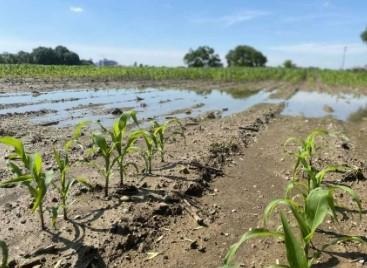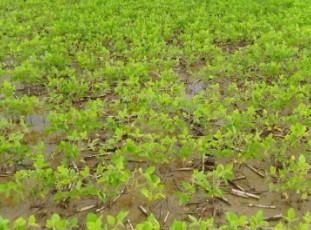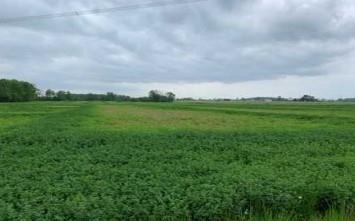Large rain events seem to be trending this year in many parts of Ohio, especially in Northwest Ohio where 3-5 inches of rain fell in 24-48 hrs. This can lead to standing water (flood) conditions or waterlogged soils (the root system is saturated).

In some areas, this may have resulted in a partial and complete immersion of plants, especially in low spots, on river bottoms, and along streams. Many crops are sensitive to excess water, but the amount of damage is typically driven by plant growth stage, rainfall intensity, and duration of saturated/flooded conditions.

Figure 1. Water standing in a corn field, V5 stage, on June 8, 2022. Franklin County, Ohio.
In corn, waterlogged conditions from V4-V16 (Figure 1) can limit yield potential by reducing ear size, the number of kernel rows per ear, and also the potential number of kernels per row. Yield loss in corn can also be affected by Nitrogen (N) application. Corn waterlogged at the V4-V5 growth stage for 3-4 days reduced yield in Ohio trials by 25-45% when 100-120 lb N were applied pre-plant and no additional nitrogen was applied compared to non-flooded plots. On the plots that had pre-plant N applied, adding 60-120 lb N post-flooding resulted in yield losses of only 3-15% compared to non-flooded controls receiving the same N application regime. Nitrogen stress (losses or lack of uptake) at the time of flooding can result in greater yield loss compared to fields with adequate nitrogen; waterlogging for 3 days with 120 or 180 lb N applied entirely after flooding had 28 or 9% lower yield compared to non-flooded plots receiving the same N program. The later the flooding occurs in corn, the less impact it has on grain yield losses. Bacteria deposited in leaf whorls by flooding may also result in diseased and dead plants. Disease problems of greater risk due to ponding include corn smut, pythium, and crazy top. If plants are covered with mud due to the excess water, photosynthesis may be limited but it is unlikely that the photosynthetic capacity of leaves has been completely destroyed. Smaller amounts of rain can wash silt off leaves allowing for resumption of photosynthesis. It will also help wash mud out of leaf whorls allowing new leaves to emerge. Wet soil conditions may also increase susceptibility to root lodging of larger plants (approaching the V10 stage or later). For corn that’s emerged, check the color of the growing point to assess plant survival after flooding. It should be white to cream-colored, while a darkening and/or softening usually precedes plant death. For corn not yet emerged, evaluate the appearance and integrity of seeds or seedlings that have yet to emerge (likely rotting if discolored and softening). Also, check for soil crusting as the soil dries, and be prepared to use a rotary hoe in the event crusting is impending emergence. Look for new leaf growth 3 to 5 days after water drains from the field.

Figure 2. Water standing in a soybean field. Symptoms of flood stress/saturated soils include yellow stunted plants.
Soybeans tend to be more sensitive to flooding stress during the reproductive stages rather than during the vegetative stages. Flooding for up to 4 days may not impact seed yield if it occurs during the vegetative (V4-V5) stages. A flood duration of 7 days or more can decrease yield by 17% to 63% in soybeans if it occurs during the vegetative stages. However, a flood duration of 4 days or greater during reproductive stages (R2-R5) can result in significant yield loss (25% to 85%). Additionally, there is a wide range in varietal tolerance to flooding for soybeans, so every variety may not be impacted the same. A greater concern may be the incidence of oomycete infection for young soybean plants, and producers may be on the lookout for Phytophthora stem and root rot later in the season. If seed treatments were employed before planting, this could help minimize those issues. At the vegetative stage, symptoms of flood stress (saturated soil) include yellow stunted plants (Figure 2) and poor root growth and nodulation.

Figure 3. Alfalfa field showing poor drainage between tile lines, Auglaise County, OH 2019. (photo by J. Stachler)
Besides corn and soybean, forages can also be impacted by heavy rainfall events. The degree of injury is dependent on species, environmental factors, and when the crop was last harvested. Alfalfa (Figure 3) is particularly sensitive to waterlogging injury, especially under high light conditions. Damage from flooding can be most severe if it occurs shortly after cutting. Harvesting alfalfa 2 and 12 days before soil flooding reduced regrowth yield by 56% and 33%, respectively. Unharvested plants were not injured with a flooding duration of up to 14 days. Be aware of these interactions and allow extra recovery time if alfalfa is waterlogged soon after cutting. Waterlogged fields should also be protected from potato leafhopper injury to avoid pest damage on top of environmental stress, especially in seedling alfalfa stands. Also, be sure to delay forage harvesting operations until soils are firm enough to avoid permanent crown damage and stand loss that will plague you for the remaining life of the stand. Severely damaged alfalfa stands can be no-till interseeded with sudangrass to increase forage yield this year.
While management options to address the flooding in the short term are limited, an understanding of the potential impacts can help producers to prepare and plan for management adjustment for the rest of the season. The excess water in crop fields has direct yield and economic implications.
Source : osu.edu